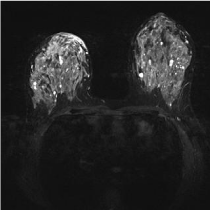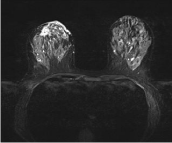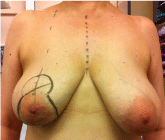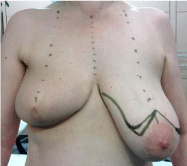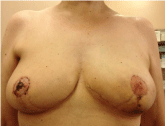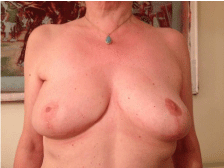Case Report
Oncoplastic Surgery for Centrally Located Breast Cancer
Bolliger M*, Wimmer K and Fitzal F
Department of Surgery, Division of General Surgery, Medical University of Vienna, Spitalgasse 23, 1090 Wien, Austria
*Corresponding author: Michael Bolliger, Department of Surgery, Division of General Surgery, Medical University of Vienna, Spitalgasse 23, 1090 Wien, Austria
Published: 20 Apr, 2017
Cite this article as: Bolliger M, Wimmer K, Fitzal F.
Oncoplastic Surgery for Centrally
Located Breast Cancer. Clin Surg.
2017; 2: 1416.
Abstract
In breast carcinomas, especially in multifocal and large tumors, the best way to operate a patient in a safe and aesthetically pleasing way is an oncoplastic operation. Otherwise, only a mastectomy would be feasible and oncologically secure. We therefore want to present a report on a quite satisfactory outcome after an Inverse-T-oncoplasty in a large invasive ductal carcinoma.
Case Presentation
This case report shows the excellent outcome, aesthetically and ontologically, of an oncoplastic
approach in a 51-year-old patient suffering from an invasive ductal breast carcinoma with favorable
tumor biology. After neoadjuvant chemotherapy the tumor shrank significantly and the central
lesion dissolved into several parts, enabling a breast-conserving therapy instead of a mastectomy.
After 5 years of follow-up the patient still remains in clinical remission. In breast carcinomas,
especially in multifocal and large tumors, the best way to operate a patient in a safe and aesthetically
pleasing way is an oncoplastic operation. Otherwise, only a mastectomy would be feasible and
ontologically secure. We therefore want to present a report on a quite satisfactory outcome after an
Inverse-T-oncoplasty in a large invasive ductal carcinoma.
In October 2010, a then 51-year-old still premenopausal female patient was admitted to our
surgical outpatient department. The patient originally noticed some suspicious skin alterations in
August 2010 and got a mammography in which a speculated breast carcinoma was found (BIRADS
5). Back then, a biopsy was taken, which revealed an invasive ductal breast carcinoma including
ductal carcinoma in situ (DCIS), with 100% reactive hormone receptors and HER2 negative and
10% MIB-1, thus being a Luminal A-tumour. In addition to the regular mammography also a MRmammography
was performed, where the main tumour was described as 45 × 34 × 35 millimeters
in size. It was irregularly configured and spiculated, lying retromammillarily with contacts to skin
and subcutanaeous tissue as well as having satellite lesions in the laterocranial quadrant distending
up to 12 millimeters (Figure 1).
Clinically, the tumour was palpable and the skin showed oozing erosion in the right areola.
Both axillas were clinically negative. The premenopausal patient was sent to the oncological
department for neoadjuvant chemotherapy to shrink the tumor preoperatively and to provide a
breast-conserving therapy to the patient. She then received four cycles of docetaxel and epirubicin
with infusions of pegfilgrastim from November 2011 until February 2011 within a 3-week schedule.
Following neoadjuvant chemotherapy MR and PET-CT showed a
partial remission, wherein the central lesion was partly dissolving,
partly flowing together. The main tumor’s diameter shrank from 4
to 2 cm, also the satellites shrank significantly, however there were
still large amounts of residual cancer cells in the central part of the
large ptotic breast (Figure 2). Surgery was done in April 2011 using
inverse-T-oncoplastic techniques with resection of the central part
of the breast including the nipple areola complex (NAC) (Figure
3 and 4). The excised specimen weighed 216 g and final pathology
revealed clear margins. The definite histology was ypT2, ypN2, ER
90%, PR80%, Her 2 neg., MIB 10% and R0. The only morbidity after
the operation was a wound seroma that had to be punctured once.
The patient entered menopause after the neoadjuvant chemotherapy, she received an additive adjuvant therapy with
tamoxifen 20 mg once daily and goserelin 3.6 mg every 28 days as well
as zolendronic acid 4 mg i.v. every 6 months to prevent osteoporosis.
Almost a year later, in February 2012, the patient received a reduction
mammoplasty for symmetry on the left side including a nipple
sharing with very good aesthetic results (Figures 4-6). The NAC on
the right side was reconstructed with the areola skin and the nipple of
the left side. No signs of malignancy could be found at that time, also
the follow-up tests in the last years never showed any suspicion for a
tumor recurrence.
Discussion
Oncoplastic surgery offers a lot of appropriate techniques based
on the location of the tumor and of course the size of the afflicted
breast and is in terms of aesthetics generally well received in patients
[1-3]. For example, lateral tumors can be treated with a glandular
flap [4], central tumors involving the nipple-areola complex with
the batwing or hemibatwing technique [5], caudal tumors with an
Inverse-T [6], not mentioning many more approaches. Regarding the
safety of this kind of operations, it has been proven that oncoplastic
surgery is also oncologically safe [7-9]. More over Chakravorty
demonstrated that the proper use of OPS significantly decreases reexcision
rates. However, data clearly show that there is an increased
risk of morbidity with age, weight, and smoking status, bleeding
disorders and diabetes as independent predictors [10]. Regarding
delay of adjuvant systemic therapy, Khan demonstrated that there
are no significant differences between lumpectomy, mastectomy,
mastectomy with immediate reconstruction and OPS in this respect
[11].
Similar cases have been reported by Bordoni and Silverstein,
among others. They both named their approach “extreme oncoplastic
surgery”, because, as in our case, they treated a large tumor with OPS
instead of a mastectomy. Both case reports had multicentric tumors
in large breasts, which enabled the surgeons to conserve the breast
with a concordant reduction mammoplasty of the other side [12-14].
Figure 1
Figure 2
Figure 3
Figure 4
Figure 5
Figure 6
Conclusion
It can be said, that in the right patients, with favourable tumor biology, yet advanced tumor size, oncoplasty is a feasible way to preserve the integrity of the breast. The only thing that hinders this possibility is a lack of training or – if the oncological breast surgeon is not capable of performing the operation alone – a lack of plastic surgeons on hand at the respective hospital. This indicates, that to establish this kind of procedure, which is an optimal treatment for the patient, every surgeon doing oncological breast surgery should at least have basic knowledge of this topic, or, even better, gain the necessary operational skills.
References
- Gnant M, Mlineritsch B, Schippinger W, Luschin-Ebengreuth G, Pöstlberger S, Menzel C, et al. Endocrine therapy plus zoledronic acid in premenopausal breast cancer. N Engl J Med. 2009;360(7):679-91.
- Macmillan RD, McCulley SJ. Oncoplastic Breast Surgery: What, When and for Whom? Curr Breast Cancer Rep. 2016;8:112-117.
- Ojala K, Meretoja TJ, Leidenius MH. Aesthetic and functional outcome after breast conserving surgery - Comparison between conventional and oncoplastic resection. Eur J Surg Oncol. 2017;43(4):658-64.
- Gurleyik G, Karagulle H, Eris E, Aker F, Ustaalioglu BO. Oncoplastic surgery; volume displacement techniques for breast conserving surgery in patients with breast cancer. Acta Chir Belg. 2017;117(3):169-75.
- Pasta V, D'Orazi V, Merola R, Frusone F, Amabile MI, De Luca A, et al. Oncoplastic central quadrantectomies. Gland Surg. 2016;5(4):422-6.
- Fitoussi A, Berry MG, Couturaud B, Salmon RJ. Oncoplastic and Reconstructive Surgery for Breast Cancer. (Springer Berlin Heidelberg, 2009).
- Nizet JL, Maweja S, Lakosi F, Lifrange E, Scagnol I, Seidel L, et al. Oncological and Surgical Outcome after Oncoplastic Breast Surgery. Acta Chir Belg. 2015;115(1):33-41.
- Chakravorty A, Shrestha AK, Sanmugalingam N, Rapisarda F, Roche N, Querci Della Rovere G, et al. How safe is oncoplastic breast conservation? Comparative analysis with standard breast conserving surgery. Eur J Surg Oncol. 2012;38(5):395-8.
- Vieira RAdC, Carrara GFA, Neto CS, Morini MA, Brentani MM, Folgueirad MAAK. The role of oncoplastic breast conserving treatment for locally advanced breast tumors. A matching case-control study. Ann Med Surg (Lond). 2016;10:61-8.
- Cil TD, Cordeiro E. Complications of Oncoplastic Breast Surgery Involving Soft Tissue Transfer Versus Breast-Conserving Surgery: An Analysis of the NSQIP Database. Ann Surg Oncol. 2016;23(10):3266-71.
- Khan J, Barrett S, Forte C, Stallard S, Weiler-Mithoff E, Doughty JC, et al. Oncoplastic breast conservation does not lead to a delay in the commencement of adjuvant chemotherapy in breast cancer patients. Eur J Surg Oncol. 2013;39(8):887-91.
- Bordoni D, Cadenelli P, Falco G, Rocco N, Manna P, Tessone A, et al. Extreme oncoplastic breast surgery: A case report. Int J Surg Case Rep. 2016;28:182-187.
- Silverstein MJ, Savalia N, Khan S, Ryan J. Extreme oncoplasty: breast conservation for patients who need mastectomy. Breast J. 2015;21(1):52-9.
- Maxwell J, Roberts A, Cil T, Somogyi R, Osman F. Current Practices and Barriers to the Integration of Oncoplastic Breast Surgery: A Canadian Perspective. Ann Surg Oncol. 2016;23(10):3259-65.

